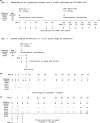An attenuated strain of enterovirus 71 belonging to genotype a showed a broad spectrum of antigenicity with attenuated neurovirulence in cynomolgus monkeys
- PMID: 17567701
- PMCID: PMC1951441
- DOI: 10.1128/JVI.02856-06
An attenuated strain of enterovirus 71 belonging to genotype a showed a broad spectrum of antigenicity with attenuated neurovirulence in cynomolgus monkeys
Abstract
Enterovirus 71 (EV71) is a causative agent of hand, foot, and mouth disease and is also sometimes associated with serious neurological disorders. In this study, we characterized the antigenicity and tissue specificity of an attenuated strain of EV71 [EV71(S1-3')], which belongs to genotype A, in a monkey infection model. Three cynomolgus monkeys were inoculated with EV71(S1-3'), followed by lethal challenge with the parental virulent strain EV71(BrCr-TR) via an intravenous route on day 45 postinoculation of EV71(S1-3'). Monkeys inoculated with EV71(S1-3') showed a mild neurological symptom (tremor) but survived lethal challenge by virulent EV71(BrCr-TR) without exacerbation of the symptom. The immunized monkey sera showed a broad spectrum of neutralizing activity against different genotypes of EV71, including genotypes A, B1, B4, C2, and C4. For the strains examined, the sera showed the highest neutralization activity against the homotype (genotype A) and the lowest neutralization activity against genotype C2. The order of decreasing neutralization activity of sera was as follows: A > B1 > C4 > B4 > C2. To examine the tissue specificity of EV71(S1-3'), two monkeys were intravenously inoculated with EV71(S1-3'), followed by examination of virus distribution in the central nervous system (CNS) and extraneural tissues. In the CNS, EV71(S1-3') was isolated only from the spinal cord. These results indicate that EV71(S1-3') acts as an effective antigen, although this attenuated strain was still neurotropic when inoculated via the intravenous route.
Figures



References
-
- Abubakar, S., H. Y. Chee, N. Shafee, K. B. Chua, and S. K. Lam. 1999. Molecular detection of enteroviruses from an outbreak of hand, foot and mouth disease in Malaysia in 1997. Scand. J. Infect. Dis. 31:331-335. - PubMed
-
- Arita, M., N. Nagata, T. Sata, T. Miyamura, and H. Shimizu. 2006. Quantitative analysis of poliomyelitis-like paralysis in mice induced by a poliovirus replicon. J. Gen. Virol. 87:3317-3327. - PubMed
-
- Arita, M., H. Shimizu, and T. Miyamura. 2004. Characterization of in vitro and in vivo phenotypes of poliovirus type 1 mutants with reduced viral protein synthesis activity. J. Gen. Virol. 85:1933-1944. - PubMed
-
- Arita, M., H. Shimizu, N. Nagata, Y. Ami, Y. Suzaki, T. Sata, T. Iwasaki, and T. Miyamura. 2005. Temperature-sensitive mutants of enterovirus 71 show attenuation in cynomolgus monkeys. J. Gen. Virol. 86:1391-1401. - PubMed
Publication types
MeSH terms
Substances
LinkOut - more resources
Full Text Sources
Other Literature Sources
Miscellaneous

